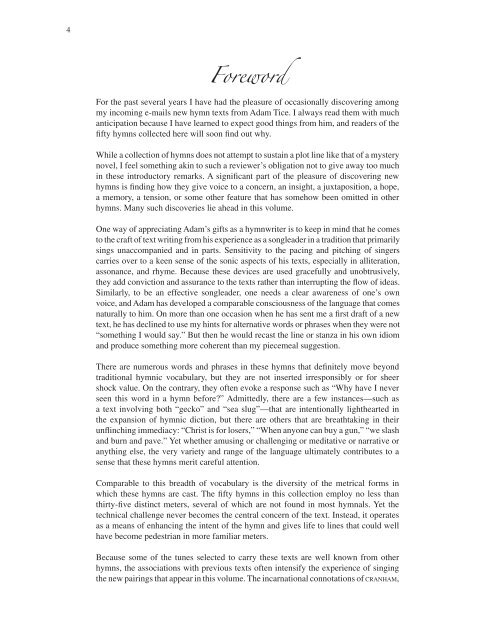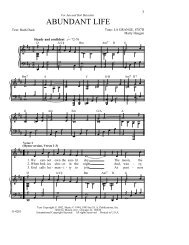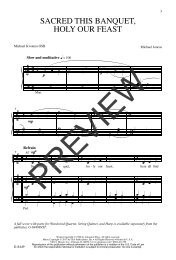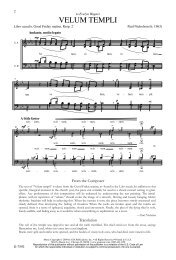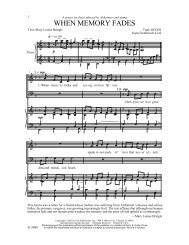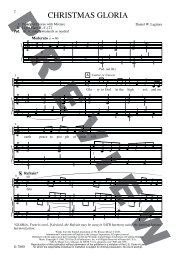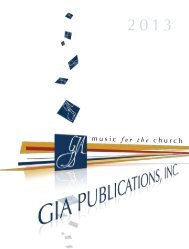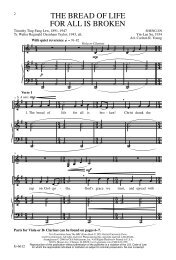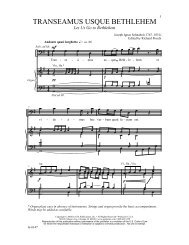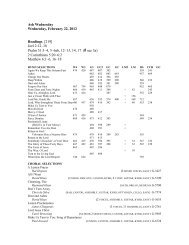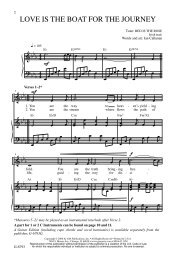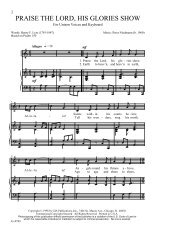G-7542 Tice Hymnary - GIA Publications
G-7542 Tice Hymnary - GIA Publications
G-7542 Tice Hymnary - GIA Publications
You also want an ePaper? Increase the reach of your titles
YUMPU automatically turns print PDFs into web optimized ePapers that Google loves.
4<br />
Foreword<br />
For the past several years I have had the pleasure of occasionally discovering among<br />
my incoming e-mails new hymn texts from Adam <strong>Tice</strong>. I always read them with much<br />
anticipation because I have learned to expect good things from him, and readers of the<br />
fifty hymns collected here will soon find out why.<br />
While a collection of hymns does not attempt to sustain a plot line like that of a mystery<br />
novel, I feel something akin to such a reviewer’s obligation not to give away too much<br />
in these introductory remarks. A significant part of the pleasure of discovering new<br />
hymns is finding how they give voice to a concern, an insight, a juxtaposition, a hope,<br />
a memory, a tension, or some other feature that has somehow been omitted in other<br />
hymns. Many such discoveries lie ahead in this volume.<br />
One way of appreciating Adam’s gifts as a hymnwriter is to keep in mind that he comes<br />
to the craft of text writing from his experience as a songleader in a tradition that primarily<br />
sings unaccompanied and in parts. Sensitivity to the pacing and pitching of singers<br />
carries over to a keen sense of the sonic aspects of his texts, especially in alliteration,<br />
assonance, and rhyme. Because these devices are used gracefully and unobtrusively,<br />
they add conviction and assurance to the texts rather than interrupting the flow of ideas.<br />
Similarly, to be an effective songleader, one needs a clear awareness of one’s own<br />
voice, and Adam has developed a comparable consciousness of the language that comes<br />
naturally to him. On more than one occasion when he has sent me a first draft of a new<br />
text, he has declined to use my hints for alternative words or phrases when they were not<br />
“something I would say.” But then he would recast the line or stanza in his own idiom<br />
and produce something more coherent than my piecemeal suggestion.<br />
There are numerous words and phrases in these hymns that definitely move beyond<br />
traditional hymnic vocabulary, but they are not inserted irresponsibly or for sheer<br />
shock value. On the contrary, they often evoke a response such as “Why have I never<br />
seen this word in a hymn before?” Admittedly, there are a few instances—such as<br />
a text involving both “gecko” and “sea slug”—that are intentionally lighthearted in<br />
the expansion of hymnic diction, but there are others that are breathtaking in their<br />
unflinching immediacy: “Christ is for losers,” “When anyone can buy a gun,” “we slash<br />
and burn and pave.” Yet whether amusing or challenging or meditative or narrative or<br />
anything else, the very variety and range of the language ultimately contributes to a<br />
sense that these hymns merit careful attention.<br />
Comparable to this breadth of vocabulary is the diversity of the metrical forms in<br />
which these hymns are cast. The fifty hymns in this collection employ no less than<br />
thirty-five distinct meters, several of which are not found in most hymnals. Yet the<br />
technical challenge never becomes the central concern of the text. Instead, it operates<br />
as a means of enhancing the intent of the hymn and gives life to lines that could well<br />
have become pedestrian in more familiar meters.<br />
Because some of the tunes selected to carry these texts are well known from other<br />
hymns, the associations with previous texts often intensify the experience of singing<br />
the new pairings that appear in this volume. The incarnational connotations of CRANHAM,


